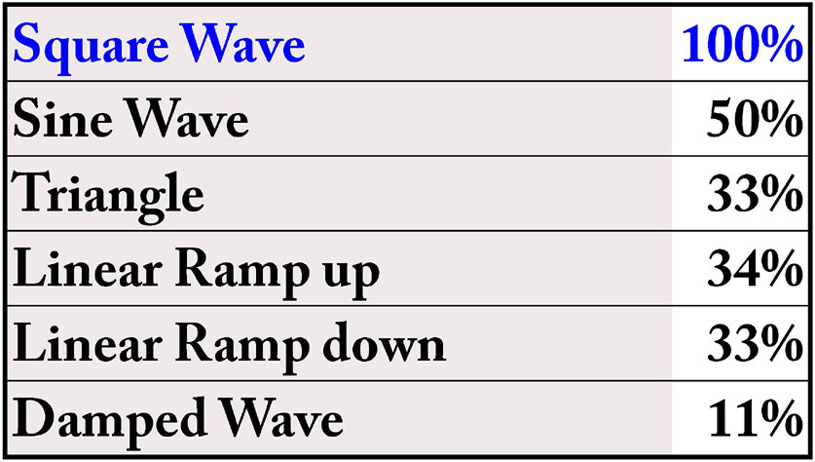(GB-4000 - M.O.P.A. - 6-Page Technical Specs Brochure) |
(GB-4000 - SR-4 - M.O.P.A. - Complete 22-Page Brochure) |
Power In Waveforms
In the chart above you will notice that the most powerful waveform is the square wave waveform. The original equipment only used three different waveforms; sine wave, damped wave, and square wave. Sine wave was used with the higher RF or radio frequencies. Damped wave was used with the audio frequencies. Audio frequencies are low frequencies and are not RF or radio frequencies. These low audio frequencies were modulated onto the RF carrier wave. Audio frequencies are generally considered to be below 40,000 Hertz or cycles per second. In 1936 the damped wave was replaced with the square wave. The following quote was taken from the original 1939 lab film starting at 17 minutes and 10 seconds. Click on the image below to watch the film.
“This shows the amplification of the signal [audio frequencies] going into the carrier wave, and the slower frequencies [audio] now being shown, which they can be varied with harmonics and other square wave waveforms that were later found to be more effective than sine wave or triangle wave or other waveforms that have been tried for years.”
 |
This quote clearly points out that the square wave waveform was found to be "more effective" than any other waveforms when used with low audio frequencies. Over 95% of all the frequencies used are low audio frequencies. If you look at the chart above you will notice that a 100% square wave is 3 times more powerful than the Triangle waveform or Linear up or down waveforms. It is 9 times more powerful than the Damped wave waveform. This is why Sinewave and Square waves were used in the original 1930s/1950s instruments.
It makes one wonder why anyone would want to use any other waveform than the most powerful waveforms with there proven results? The fact is the original 1936/1950's instruments which used square waves worked the best and didn't use any of these other less powerful waveforms, which only confuse people. We could also output these other less powerful waveforms, but if the user has the choice, they always want to use the most powerful and effective waveform. It is for these reasons we only use the most powerful waveforms with the GB-4000, SR-4, and M.O.P.A.
The duty cycle of a square wave is the ON and OFF time of a waveform. If you have a 100% duty cycle then you have 100% of the power in the frequency you are running, due to the fact that there is no OFF time. So the higher the duty cycle number (1% to 100%) the greater the power output in a frequency. Also, it needs to be understood that the higher the duty cycle the more power that is required to output the frequency. If you have a true 50-watt frequency generator the circuit must be able to run a 100% duty cycle continuously at 50-watts. Only then will it be a true 50-watt instrument. If it can only run a 50% duty cycle then it is only a 50-watt circuit that is capable of ½ the power output or 25 watts. So it is important to keep in mind that the true power output of a circuit is determined by the duty cycle it can handle. The 1930's/1950's equipment was powerful enough to run any frequency continuously at a 100% duty cycle even though they mostly ran a 50% duty cycle. Because of this, they were true 50 to 75-watt ray tube instruments.
There are many other manufacturers of frequency generators that use these different waveforms and they claim, without any documented supporting proof, that these other waveforms make their instrument superior to the original equipment. They claim they use these other waveforms because there is a possibility that the original waveforms "may be rejected." If this was true then there could never be a resonant frequency for anything. Also if this was true then there would be no reason to ever use this resonant frequency method because it contradicts all the proven work that has been done. There is either a resonant frequency or there is not.
